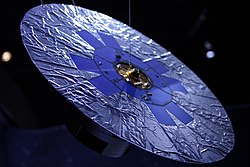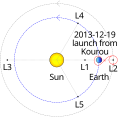Gaia (spacecraft)
Gaia was a space observatory. It was launched by the European Space Agency (ESA) on 19 December 2013.[1] The mission aims to compile a 3D space catalogue of about one billion astronomical objects.[2][3] The mission ended in March 27, 2025.
It will study about 1% of the Milky way population.[4][5] A successor to the Hipparcos mission, it is part of ESA's Horizon 2000 Plus long-term scientific program. Gaia monitored each of its target stars about 70 times over a period of five years.
Gaia created an extremely precise three-dimensional map of stars throughout the Milky Way galaxy and map their motions. This data is a product of the origin and subsequent evolution of the Milky Way. The spectroscopic measurements will find the physical properties of each star observed, their luminosity, temperature, gravity and elemental composition. Distances to about 20 million stars will be measured by annual parallax.
The massive stellar census will provide the basic observational data. With the data, astronomers hope to tackle a range of important problems, like the origin, structure, and evolutionary history of our galaxy. Large numbers of quasars, galaxies, extrasolar planets and Solar System bodies will be measured at the same time.
Gaia was launched using a Soyuz rocket from its Guiana Space Centre (GSC) in French Guiana.[6][7] It is in a Lissajous orbit around the Sun–Earth L2 Lagrangian point. As of April 2018 it has measured approximately a billion stars and other objects.
Gaia (spacecraft) Media
VST snaps Gaia en route to a billion stars
References
- ↑ "ESA Gaia home". ESA. Retrieved 23 October 2013. [1]
- ↑ Amos, Jonathan 2013. Gaia: The 'impossible space mission' ready to fly. BBC Science & Environment. [2]
- ↑ "Science Knowledge: we have already installed the eye of 'Gaia' with a billion pixels to study the Milky Way. 14 July 2011". Archived from the original on 28 March 2019. Retrieved 19 December 2013.
- ↑ ESA Gaia spacecraft summary, 20 May 2011
- ↑ "Cosmos Home - Cosmos".
- ↑ Staff (November 19, 2012). "Announcement of Opportunity for the Gaia Data Processing Archive Access Co-Ordination Unit". ESA. Retrieved March 17, 2013.
- ↑ arianespace.com Arianespace to launch Gaia; European Space Agency mission will observe a billion stars in our galaxy. 2009






